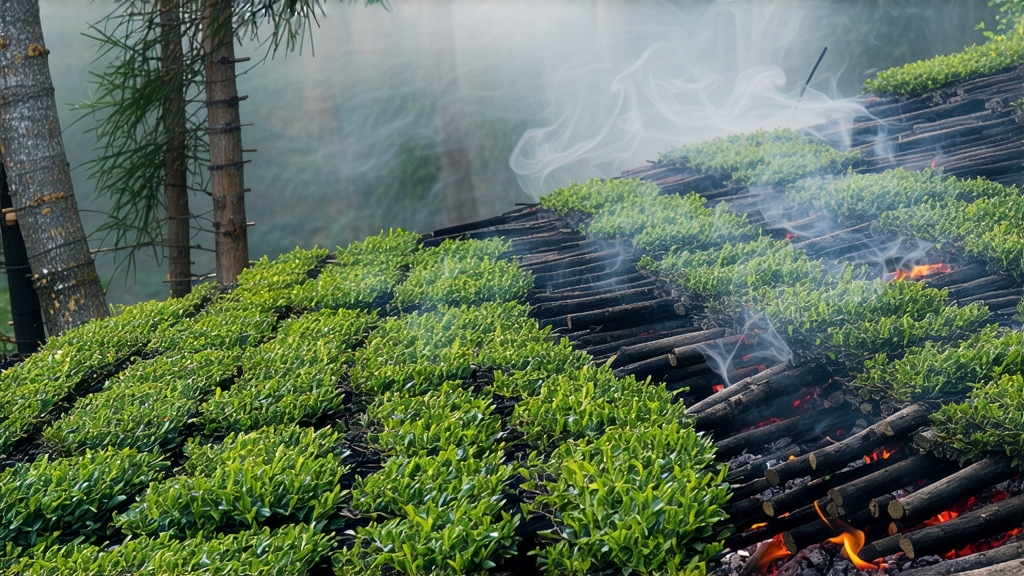
When European tea drinkers first encountered the dark, twisted leaves that produced a liquor the color of claret and a scent reminiscent of campfire and treacle, they did not yet have the vocabulary to call it “black tea.” In the early seventeenth-century ports of Amsterdam and London the cargo was simply labeled “bohea,” a corruption of the Wuyi range in northern Fujian where the tea was grown. That original bohea was Lapsang Souchong—today celebrated as the first fully oxidized tea in history and the prototype for every subsequent black tea from Assam to Ceylon.
Geography and legend intertwine among the granite cliffs of the Wuyi Mountains, a UNESCO World Heritage site whose cool mists, mineral-rich soils, and subtropical monsoon climate create an ideal terroir for the xiao zhong cultivar. According to local lore, the smoking process was born of military urgency: Qing-era soldiers passing through the village of Tongmu requisitioned tea sheds for barracks, forcing farmers to hastily dry their fresh leaves over fresh pine fires so the crop could be moved before nightfall. The accidental alchemy yielded a tea that traveled so well along the Tea Road to Moscow and London that Russian and British merchants returned year after year asking for “the smoky kind.”
Modern Lapsang Souchong is still produced only within the 600 km² core protection zone of the Wuyi National Nature Reserve. The highest grade, known as “wild zhengshan xiaozhong,” is picked from uncultivated tea trees scattered at 1,200–1,500 m above sea level. Only the tender two leaves and a bud are plucked during the brief spring window when mountain temperatures fluctuate between 12 °C and 18 °C, concentrating aromatic compounds. A single mu (⅙ hectare) of such forest garden may yield barely twenty kilograms of finished tea, less than one-tenth the output of conventional black tea gardens.
Craft begins the moment the leaves arrive at the tiny Tongmu workshops. Withering is conducted on bamboo trays suspended over dying embers of local Masson pine; the gentle warmth (28–30 °C) deactivates grassy enzymes while allowing the leaf to retain enough moisture for rolling. Master craftsmen judge the withering stage by the sound—when a handful of leaves rustles like autumn parchment, it is time for rolling. A 45-minute machine roll bruises cell walls without breaking them, initiating oxidation that will later be fixed by heat. The rolled leaf is then placed in wooden barrels lined with wet cloths, where it ferments for three to four hours in a room kept at 24 °C and 80 % humidity. Oxidation is arrested by a short bake (ten minutes at 110 °C) before the signature smoking begins.
Smoking is not merely a flavoring step; it is a slow drying process that reduces moisture from 60 % to below 7 % while infusing the leaf with resinous volatiles. The tea is spread on multi-tiered bamboo racks inside a brick oven called a qinglou. Below, pine logs smolder for six to eight hours, never flaming, their blue smoke wafting upward through a maze of damp tea. The best producers repeat this cycle on three consecutive nights, using only the heartwood of 40-year-old pines that have been seasoned for twelve months. The result is a leaf that gleams obsidian under light, releasing aromas of longan, pine balsam, and a whisper of pipe tobacco.
Western palates often expect an aggressive campfire punch, yet a properly crafted Lapsang Souchong is nuanced. The liquor glows amber-red, its rim turning golden in the cup. First infusions deliver a sweet, almost jammy note of dried longan, followed by a warm cedar mid-palate and a lingering coolness reminiscent of mint and camphor. The smoke is present but integrated, more like the memory of a pine forest than the soot of a barbecue. Second and third steepings reveal cocoa and honey layers, while later infusions turn silky, with a mineral finish borrowed from the Wuyi rock substrate.
To unlock these subtleties, gongfu brewing is essential. Begin by pre-warming a small Yixing teapot or gaiwan (100–120 ml) with 95 °C water. Measure 5 g of leaf—about two heaping teaspoons—into the pot. The first rinse (five seconds) is discarded to awaken the leaf and wash away surface smoke. Subsequent steeps